Holocene and Late Pleistocene Flood Events in Central Europe Reconstructed from Eifel Maar Lake Sediments
Abstract
1. Introduction
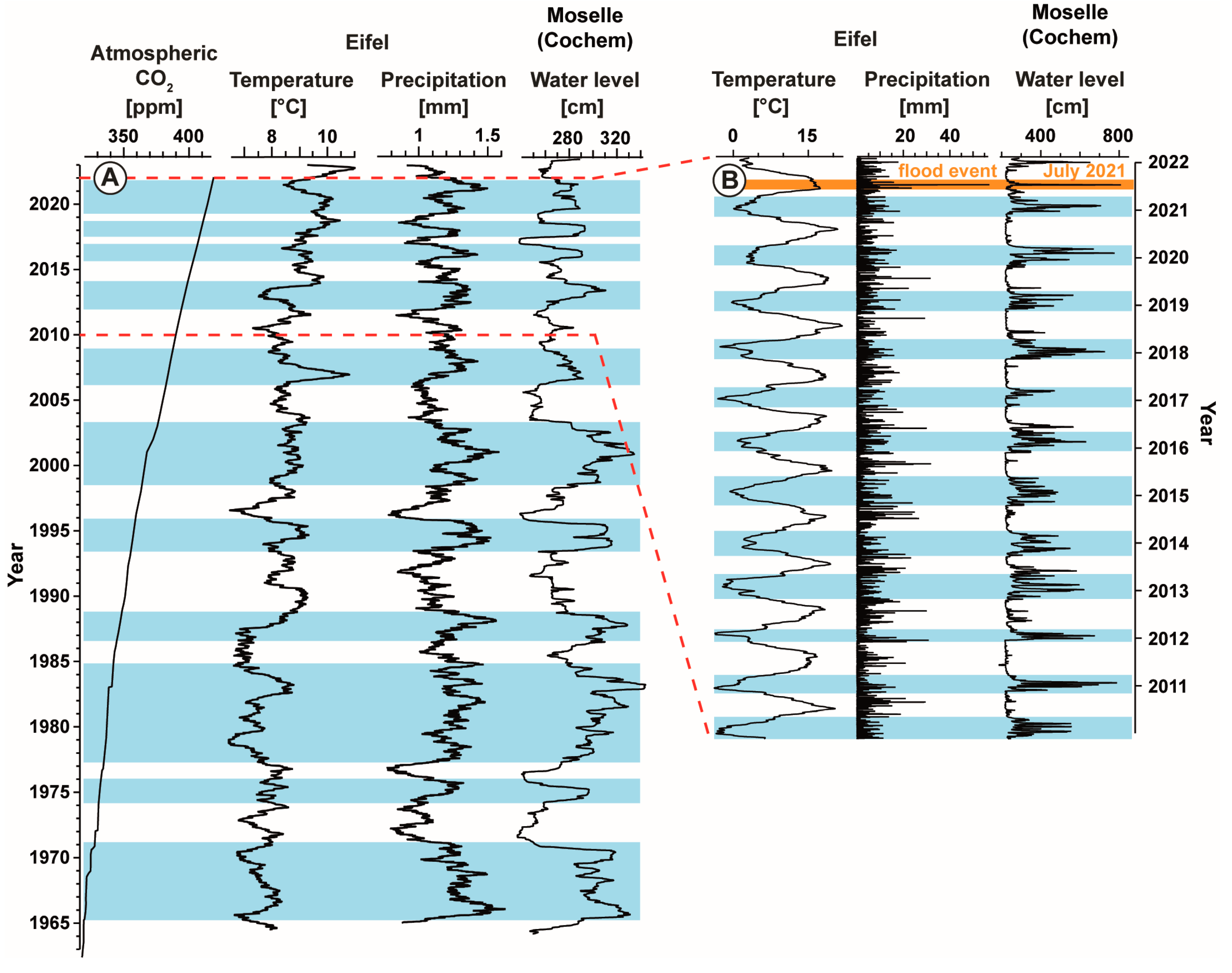
2. Materials and Methods
2.1. Coring Sites
2.2. Flood Layers
3. Results
3.1. Present–9000 yr b2k (The Maar Lakes of Schalkenmehren and Ulmen)
3.2. 10,000–60,000 yr b2k (The Auel Infilled Maar)
4. Discussion
4.1. Late Pleistocene Flood Phases
4.2. Holocene Flood Activity
5. Conclusions
- Holocene flood events are mainly summer floods in mild, interglacial climate conditions;
- During the early and middle Holocene, multi-centennial cycles of increased flood frequency were driven by natural processes;
- As humans settled in the Eifel region at around 3700 yr b2k and actively impacted their environment through agricultural activity, floods occurred much more frequently, peaking in the 13th and 14th centuries during the medieval agricultural revolution;
- Late Pleistocene floods occurred during the YD cold phase and Heinrich stadials, representing increased soil erosion effects due to a decline in stabilizing vegetation cover in cold and dry climates.
Supplementary Materials
Author Contributions
Funding
Data Availability Statement
Acknowledgments
Conflicts of Interest
References
- Tradowsky, J.S.; Philip, S.Y.; Kreienkamp, F.; Kew, S.F.; Lorenz, P.; Arrighi, J.; Bettmann, T.; Caluwaerts, S.; Chan, S.C.; De Cruz, L.; et al. Attribution of the heavy rainfall events leading to severe flooding in Western Europe during July 2021. Clim. Change 2023, 176, 90. [Google Scholar] [CrossRef]
- Mohr, S.; Ehret, U.; Kunz, M.; Ludwig, P.; Caldas-Alvarez, A.; Daniell, J.E.; Ehmele, F.; Feldmann, H.; Franca, M.J.; Gattke, C.; et al. A multi-disciplinary analysis of the exceptional flood event of July 2021 in central Europe—Part 1: Event description and analysis. Nat. Hazards Earth Syst. Sci. 2023, 23, 525–551. [Google Scholar] [CrossRef]
- Roggenkamp, T.; Herget, J. Flood reconstruction—The unexpected rather frequent event at River Ahr in July 2021. Glob. Planet Change 2024, 240, 104541. [Google Scholar] [CrossRef]
- Flooding in Altenahr Altenburg, Rhineland-Palatinate, Germany. Available online: https://en.wikipedia.org/wiki/2021_European_floods#/media/File:Hochwasser_in_Altenahr_Altenburg.jpg (accessed on 19 October 2025).
- Glaser, R.; Stangl, H. Climate and Floods in Central Europe since AD 1000: Data, Methods, Results and Consequences. Surv. Geophys. 2004, 25, 485–510. [Google Scholar] [CrossRef]
- Glaser, R.; Riemann, D.; Schönbein, J.; Barriendos, M.; Brázdil, R.; Bertolin, C.; Camuffo, D.; Deutsch, M.; Dobrovolný, P.; van Engelen, A. The variability of European floods since AD 1500. Clim. Change 2010, 101, 235–256. [Google Scholar] [CrossRef]
- Brázdil, R.; Glaser, R.; Pfister, C.; Dobrovolny, P.; Antoine, J.-M.; Barriendos, M.; Camuffo, D.; Deutsch, M.; Enzi, S.; Guidoboni, E. Flood Events of Selected European Rivers in the Sixteenth Century. Clim. Change 1999, 43, 239–285. [Google Scholar] [CrossRef]
- Sartor, J. Zur Hochwasserhistorie der deutschen und luxemburgischen Mosel. Korresp. Wasserwirtsch. 2020, 13, 604–608. [Google Scholar] [CrossRef]
- Mauna Loa CO2 Annual Mean Data. Available online: https://gml.noaa.gov/webdata/ccgg/trends/co2/co2_annmean_mlo.txt (accessed on 19 October 2025).
- Rubino, M.; Etheridge, D.M.; Trudinger, C.M.; Allison, C.E.; Battle, M.O.; Langenfels, R.L.; Steele, L.P.; Curran, M.; Bender, M.; White, J.W.C.; et al. A revised 1000 year atmospheric δ13C-CO2 record from Law Dome and South Pole, Antarctica. J. Geophys. Res. Atmos. 2013, 118, 8482–8499. [Google Scholar] [CrossRef]
- Hersbach, H.; Bell, B.; Berrisford, P.; Biavati, G.; Horányi, A.; Muñoz Sabater, J.; Nicolas, J.; Peubey, C.; Radu, R.; Rozum, I.; et al. ERA5 Hourly Data on Single Levels from 1940 to Present. Copernicus Climate Change Service (C3S) Climate Data Store (CDS). 2023. Available online: https://cds.climate.copernicus.eu/datasets/reanalysis-era5-single-levels?tab=overview (accessed on 3 May 2023). [CrossRef]
- Brázdil, R.; Kundzewicz, Z.W.; Benito, G.; Demarée, G.; Macdonald, N.; Roald, L.A. Historical Floods in Europe in the Past Millennium. In Changes in Flood Risk in Europe; Kundzewicz, Z.W., Ed.; IAHS Press: Wallingford, UK, 2012; pp. 121–166. [Google Scholar]
- Siegenthaler, C.; Sturm, M. Die Häufigkeit von Ablagerungen extremer Reuss-Hochwasser. Die Sedimentationsgeschichte im Urnersee seit dem Mittelalter. In Ursachenanalyse der Hochwasser 1987; Bundesamt für Umwelt (BAFU): Bern, Switzerland, 1991; pp. 127–139. [Google Scholar]
- Alexandre, P. Le climat en Europe au Moyen Age. In Contribution à L’histoire des Variations Climatiques de 1000 à 1425, D’après les Sources Narratives de l’Europe Occidentale; École des Hautes Études en Sciences Sociales: Paris, France, 1987. [Google Scholar]
- Herget, J.; Kapala, A.; Krell, M.; Rustemeier, E.; Wyss, A. The millennium flood of July 1342 revisited. Catena 2015, 130, 82–94. [Google Scholar] [CrossRef]
- Kiss, A. Introduction: Floods and Water-Level Fluctuations in Medieval (Central-)Europe. In Floods and Long-Term Water-Level Changes in Medieval Hungary; Kiss, A., Ed.; Springer International Publishing: Cham, Switzerland, 2019; pp. 1–50. [Google Scholar] [CrossRef]
- Jacobeit, J.; Glaser, R.; Luterbacher, J.; Wanner, H. Links between flood events in central Europe since AD 1500 and large-scale atmospheric circulation modes. Geophys. Res. Lett. 2003, 30, 1172. [Google Scholar] [CrossRef]
- Brázdil, R.; Kundzewicz, Z.W.; Benito, G. Historical hydrology for studying flood risk in Europe. Hydrol. Sci. J. 2006, 51, 739–764. [Google Scholar] [CrossRef]
- Glur, L.; Wirth, S.B.; Büntgen, U.; Gilli, A.; Haug, G.H.; Schär, C.; Beer, J.; Anselmetti, F.S. Frequent floods in the European Alps coincide with cooler periods of the past 2500 years. Sci. Rep. 2013, 3, 2770. [Google Scholar] [CrossRef] [PubMed]
- Hoffmann, T.; Lang, A.; Dikau, R. Holocene river activity: Analysing 14C-dated fluvial and colluvial sediments from Germany. Quat. Sci. Rev. 2008, 27, 2031–2040. [Google Scholar] [CrossRef]
- Hoffmann, T.; Erkens, G.; Gerlach, R.; Klostermann, J.; Lang, A. Trends and controls of Holocene floodplain sedimentation in the Rhine catchment. CATENA 2009, 77, 96–106. [Google Scholar] [CrossRef]
- Macklin, M.G.; Benito, G.; Gregory, K.J.; Johnstone, E.; Lewin, J.; Michczyñska, D.J.; Soja, R.; Starkel, L.; Thorndycraft, V.R. Past hydrological events reflected in the Holocene fluvial record of Europe. CATENA 2006, 66, 145–154. [Google Scholar] [CrossRef]
- Kalicki, T.; Sauchyk, S.; Calderoni, G.; Simakova, G. Climatic versus human impact on the Holocene sedimentation in river valleys of different order: Examples from the Upper Dnieper basin, Belarus. Quat. Int. 2008, 189, 91–105. [Google Scholar] [CrossRef]
- Benito, G.; Mackling, M.G.; Panin, S.; Fontana, A.; Jones, A.F.; Machado, M.J.; Matlakhova, E.; Mozzi, P.; Zielhofer, C. Recurring flood distribution patterns related to short-term Holocene climatic variability. Sci. Rep. 2015, 5, 16398. [Google Scholar] [CrossRef] [PubMed]
- Bond, G.; Kromer, B.; Beer, J.; Muscheler, R.; Evans, M.N.; Showers, W.; Hoffmann, S.; Lotti-Bond, R.; Hajdas, I.; Bonani, G. Persistent Solar Influence on North Atlantic Climate During the Holocene. Science 2001, 294, 2130–2136. [Google Scholar] [CrossRef]
- Berger, A.; Loutre, M.F. Insolation values for the climates of the last 10 million years. Quat. Sci. Rev. 1991, 10, 297–317. [Google Scholar] [CrossRef]
- Macklin, M.G.; Lewin, J. River sediments, great floods and centennial-scale Holocene climate change. J. Quat. Sci. 2003, 18, 101–105. [Google Scholar] [CrossRef]
- Notebaert, B.; Verstraeten, G. Sensitivity of West and Central European river systems to environmental changes during the Holocene: A review. Earth Sci. Rev. 2010, 103, 163–182. [Google Scholar] [CrossRef]
- Rădoane, M.; Chiriloaei, F.; Sava, T.; Nechita, C.; Rădoane, N.; Gâza, O. Holocene fluvial history of Romanian Carpathian rivers. Quat. Int. 2019, 527, 113–129. [Google Scholar] [CrossRef]
- Swierczynski, T.; Lauterbach, S.; Dulski, P.; Delgado, J.; Merz, B.; Brauer, A. Mid- to late Holocene flood frequency changes in the northeastern Alps as recorded in varved sediments of Lake Mondsee (Upper Austria). Quat. Sci. Rev. 2013, 80, 78–90. [Google Scholar] [CrossRef]
- Lauterbach, S.; Chapron, E.; Brauer, A.; Huls, M.; Gilli, A.; Arnaud, F.; Piccin, A.; Nomade, J.; Desmet, M.; von Grafenstein, U.; et al. A sedimentary record of Holocene surface runoff events and earthquake activity from Lake Iseo (Southern Alps, Italy). Holocene 2012, 22, 749–760. [Google Scholar] [CrossRef]
- Wirth, S.B.; Glur, L.; Gilli, A.; Anselmetti, F.S. Holocene flood frequency across the Central Alps—Solar forcing and evidence for variations in North Atlantic atmospheric circulation. Quat. Sci. Rev. 2013, 80, 112–128. [Google Scholar] [CrossRef]
- Heinrich, H. Origin and consequences of cyclic ice rafting in the northeast Atlantic Ocean during the past 130,000 years. Quat. Res. 1988, 2, 143–152. [Google Scholar] [CrossRef]
- Lynch-Stieglitz, J.; Schmidt, M.; Gene Henry, L.; Curry, W.B.; Skinner, L.C.; Mulitza, S.; Zhang, R.; Chang, P. Muted change in Atlantic overturning circulation over some glacial-aged Heinrich events. Nat. Geosci. 2014, 7, 144–150. [Google Scholar] [CrossRef]
- Davtian, N.; Bard, E. A new view on abrupt climate changes and the bipolar seesaw based on paleotemperatures from Iberian Margin sediments. Proc. Natl. Acad. Sci. USA 2023, 120, e2209558120. [Google Scholar] [CrossRef] [PubMed]
- Genty, D.; Combourieu-Nebout, N.; Peyron, O.; Blamart, D.; Wainer, K.; Mansuri, F.; Ghaleb, B.; Isabello, L.; Dormoy, I.; von Grafenstein, U.; et al. Isotopic characterization of rapid climatic events during OIS3 and OIS4 in Villars Cave stalagmites (SW-France) and correlation with Atlantic and Mediterranean pollen records. Quat. Sci. Rev. 2010, 29, 2799–2820. [Google Scholar] [CrossRef]
- Fuhrmann, F.; Seelos, K.; Sirocko, F. Eolian Sedimentation in Central European Auel Dry Maar from 60 to 13 Ka. Quat. Res. 2021, 101, 4–12. [Google Scholar] [CrossRef]
- Prud’homme, C.; Fischer, P.; Jöris, O.; Gromov, S.; Vinnepand, M.; Hatté, C.; Vonhof, H.; Moine, O.; Vött, A.; Fitzsimmons, K.E. Millennial-timescale quantitative estimates of climate dynamics in central Europe from earthworm calcite granules in loess deposits. Commun. Earth Environ. 2022, 3, 267. [Google Scholar] [CrossRef]
- Westaway, R.; Bridgland, D.R. Causes, consequences and chronology of large-magnitude palaeoflows in Middle and Late Pleistocene river systems of northwest Europe. Earth Surf. Process Landforms 2010, 35, 1071–1097. [Google Scholar] [CrossRef]
- Albert, J.; Sirocko, F. Evidence for an extreme cooling event prior to the Laschamp geomagnetic excursion in Eifel maar sediments. Quaternary 2023, 6, 14. [Google Scholar] [CrossRef]
- Hoch- und Niedrigwasser der Mosel. Available online: https://www.puenderich.de/puenderich/dorfchronik-und-geschichte/hochwasser-und-eisgang (accessed on 19 October 2025).
- Brunck, H.; Sirocko, F.; Albert, J. The ELSA-Flood-Stack: A reconstruction from the laminated sediments of Eifel maar structures during the last 60,000 years. Glob. Planet. Change 2016, 142, 136–146. [Google Scholar] [CrossRef]
- Sirocko, F.; Martinez-García, A.; Mudelsee, M.; Albert, J.; Britzius, S.; Christl, M.; Diehl, D.; Diensberg, B.; Friedrich, R.; Fuhrmann, F.; et al. Muted Multidecadal climate variability in central Europe over the past 60,000 years. Nat. Geosci. 2021, 14, 651–658. [Google Scholar] [CrossRef]
- Albert, J.; Zander, P.D.; Grosjean, M.; Sirocko, F. Fine-Tuning of Sub-Annual Resolution Spectral Index Time Series from Eifel Maar Sediments, Western Germany, to the NGRIP δ18O Chronology, 26–60 ka. Quaternary 2024, 7, 33. [Google Scholar] [CrossRef]
- Thorndycraft, V.R.; Benito, G.; Rico, M.; Sopea, A.; Sánchez-Moya, Y.; Casas, A. A long-term flood discharge record derived from slackwater flood deposits of the Llobregat River, NE Spain. J. Hydrol. 2005, 313, 16–31. [Google Scholar] [CrossRef]
- Büchel, G. Vulkanologische Karte der West-und Hocheifel; Landesvermessungsamt Rheinland-Pfalz: Koblenz, Germany, 1994. [Google Scholar]
- Förster, M.W.; Sirocko, F. The ELSA-Tephra-Stack: Volcanic activity in the Eifel during the last 500,000 years. Glob. Planet. Change 2016, 142, 100–107. [Google Scholar] [CrossRef]
- Seelos, K.; Sirocko, F.; Dietrich, S. A continuous high-resolution dust record for the reconstruction of wind systems in central Europe (Eifel, Western Germany) over the past 133 ka. Geophys. Res. Lett. 2009, 36, L20712. [Google Scholar] [CrossRef]
- Sirocko, F.; Albert, J.; Britzius, S.; Dreher, F.; Martínez-García, A.; Dosseto, A.; Burger, J.; Terberger, T.; Haug, G. Thresholds for the presence of Glacial megafauna in central Europe during the last 60,000 years. Sci. Rep. 2022, 12, 20055. [Google Scholar] [CrossRef]
- Britzius, S.; Dreher, F.; Maisel, P.; Sirocko, F. Vegetation Patterns during the Last 132,000 Years: A Synthesis from Twelve Eifel Maar Sediment Cores (Germany): The ELSA-23-Pollen-Stack. Quaternary 2024, 7, 8. [Google Scholar] [CrossRef]
- Sirocko, F.; Krebsbach, F.; Albert, J.; Britzius, S.; Schenk, F.; Förster, M.W. Relation between the central European climate change and Eifel volcanism during the last 130,000 years: The ELSA-23 Tephra Stack. Quaternary 2024, 7, 21. [Google Scholar] [CrossRef]
- Büchel, G.; Krawczyk, E. Zur Genese der Dauner Maare im Vulkanfeld der Westeifel. Mainzer Geowiss. Mitt. 1986, 15, 219–238. [Google Scholar]
- Heinz, T.; Rein, B.; Negendank, J.F.W. Sediments and basin analysis of Lake Schalkenmehrener Maar. In Paleolimnology of European Maar Lakes. Lecture Notes in Earth Sciences; Negendank, J.F.W., Zolitschka, B., Eds.; Springer: Berlin/Heidelberg, Germany, 1993; Volume 49. [Google Scholar] [CrossRef]
- Straka, H. Die spätquartäre Vegetationsgeschichte der Vulkaneifel. Beiträge Zur Landespfl. Rheinl.-Pfalz. 1975, 3, 1–163. [Google Scholar]
- Fritz, T. Varvenchronologie der Letzten 1000 Jahre Anhand Ausgewählter Eifelmaare (Holzmaar, Schalkenmehrener Maar, Ulmener Maar). Diploma Thesis, Johannes Gutenberg University, Mainz, Germany, 2011. [Google Scholar]
- Sirocko, F.; Knapp, H.; Dreher, F.; Förster, M.W.; Albert, J.; Brunck, H.; Veres, D.; Dietrich, S.; Zech, M.; Hambach, U.; et al. The ELSA-Vegetation-Stack: Reconstruction of Landscape Evolution Zones (LEZ) from laminated Eifel maar sediments of the last 60,000 years. Glob. Planet Change 2016, 142, 108–135. [Google Scholar] [CrossRef]
- Sirocko, F.; Dietrich, S.; Veres, D.; Grootes, P.; Schaber-Mohr, K.; Seelos, K.; Nadeau, M.-J.; Kromer, B.; Rothacker, L.; Röhner, M.; et al. Multi-Proxy-Dating of Holocene maar lakes and Pleistocene dry maar sediments in the Eifel, Germany. Quat. Sci. Rev. 2013, 62, 56–72. [Google Scholar] [CrossRef]
- Rasmussen, S.O.; Bigler, M.; Blockley, S.P.; Blunier, T.; Buchardt, S.L.; Clausen, H.B.; Cvijanovic, I.; Dahl-Jensen, D.; Johnsen, S.J.; Fischer, H.; et al. A stratigraphic framework for abrupt climatic changes during the Last Glacial period based on three synchronized Greeland ice-core records: Refining and extending the INTIMATE event stratigraphy. Quat. Sci. Rev. 2014, 106, 14–28. [Google Scholar] [CrossRef]
- Steinhilber, F.; Abreu, J.A.; Beer, J.; Brunner, I.; Christl, M.; Fischer, H.; Heikkilä, U.; Kubik, P.W.; Mann, M.; McCracken, K.G.; et al. 9400 years of cosmic radiation and solar activity from ice cores and tree rings. Proc. Natl. Acad. Sci. USA 2012, 109, 5967–5971. [Google Scholar] [CrossRef]
- Zander, P.D.; Böhl, D.; Sirocko, F.; Auderset, A.; Haug, G.; Martínez-García, A. Reconstruction of warm season temperatures in central Europe during the past 60,000 years from lacustrine GDGTs. Clim. Past 2023, 20, 841–864. [Google Scholar] [CrossRef]
- Monnin, E.; Indermühle, A.; Dällenbach, A.; Flückiger, J.; Stauffer, B.; Stocker, T.F.; Raynaud, S.; Barnola, J.-M. Atmospheric CO2 Concentrations over the Last Glacial Termination. Science 2001, 291, 112–114. [Google Scholar] [CrossRef]
- Monnin, E.; Steig, E.J.; Siegenthaler, U.; Kawamura, K.; Schwander, J.; Stauffer, B.; Stocker, T.F.; Morse, D.L.; Barnola, J.-M.; Bellier, B.; et al. Evidence for substantial accumulation rate variability in Antarctica during the Holocene, through synchronization of CO2 in the Taylor Dome, Dome C and DML ice cores. Earth Planet. Sci. Lett. 2004, 224, 45–54. [Google Scholar] [CrossRef]
- MacFarling Meure, C.; Etheridge, D.; Trudinger, C.; Steele, P.; Langernfelds, R.; van Ommen, T.; Smith, A.; Elkins, J. Law Dome CO2, CH4 and N2O ice core records extended to 2000 years BP. Geophys. Res. Lett. 2006, 33, L14810. [Google Scholar] [CrossRef]
- Marcott, S.A.; Bauska, T.K.; Buizert, C.; Steig, E.J.; Rosen, J.L.; Cuffey, K.M.; Fudge, T.; Severinghaus, J.P.; Ahn, J.; Kalk, M.L.; et al. Centennial-scale changes in the global carbon cycle during the last deglaciation. Nature 2014, 514, 616–619. [Google Scholar] [CrossRef]
- Bereiter, B.; Lüthi, D.; Siegrist, M.; Schüpbach, S.; Stocker, T.F.; Fischer, H. Mode change of millennial CO2 variability during the last glacial cycle associated with a bipolar marine carbon seesaw. Proc. Natl. Acad. Sci. USA 2012, 109, 9755–9760. [Google Scholar] [CrossRef]
- Ahn, J.; Brook, E.J. Siple Dome ice reveals two modes of millennial CO2 change during the last ice age. Nat. Commun. 2014, 5, 3723. [Google Scholar] [CrossRef]
- Naafs, B.D.A.; Hefter, J.; Grützner, J.; Stein, R. Warming of surface waters in the mid-latitude North Atlantic during Heinrich events. Paleoceanography 2013, 28, 153–163. [Google Scholar] [CrossRef]
- Naughton, F.; Sánchez-Goñi, M.F.; Landais, A.; Rodrigues, T.; Vazquez Riveiros, N.; Toucanne, S. Chapter 7—The Younger Dryas Stadial. In European Glacial Landscapes. The Last Deglaciation; Palacios, D., Hughes García-Ruiz, J.M., Hughes, P.D., Andrés, N., Eds.; Elsevier: Amsterdam, The Netherlands; Oxford, UK; Cambridge, MA, USA, 2022; pp. 51–57. [Google Scholar] [CrossRef]
- García-Ruiz, J.M. The effects of land uses on soil erosion in Spain: A review. Catena 2010, 81, 1–11. [Google Scholar] [CrossRef]
- Oktan, E.; Kezik, U.; Hacisalihoglu, S.; Yucesan, Z. Effects of Deforestation on Soil Erosion and Carbon Sequestration in the Soil. Fresenius Environ. Bull. 2022, 31, 2239–2249. [Google Scholar]
- Pedro, J.B.; Andersson, C.; Vettoretti, G.; Voelker, A.H.L.; Waelbroeck, C.; Dokken, T.M.; Jensen, M.F.; Rasmussen, S.O.; Sessford, E.G.; Jochum, M.; et al. Dansgaard-Oeschger and Heinrich event temperature anomalies in the North Atlantic set by sea ice, frontal position and thermocline structure. Quat. Sci. Rev. 2022, 289, 107599. [Google Scholar] [CrossRef]
- Sánchez Goñi, M.F.; Fourcade, T.; Salonen, S.; Lesven, J.; Frigola, J.; Swingedouw, D.; Sierro, F.J. Muted cooling and drying of NW Mediterranean in response to the strongest last glacial North American ice surges. GSA Bull. 2020, 133, 451–460. [Google Scholar] [CrossRef]
- Clark, P.U.; Dyke, A.S.; Shakun, J.D.; Carlson, A.E.; Clark, J.; Wohlfarth, B.; Mitrovica, J.X.; Hostetler, S.W.; Mc-Cabe, A.M. The Last Glacial Maximum. Science 2009, 325, 710–714. [Google Scholar] [CrossRef]
- Seguinot, J.; Ivy-Ochs, S.; Jouvet, G.; Huss, M.; Funk, M.; Preusser, F. Modelling last glacial cycle ice dynamics in the Alps. Cryosphere 2018, 12, 3265–3285. [Google Scholar] [CrossRef]
- Bekaert, D.V.; Blard, P.-H.; Raoult, Y.; Pik, R.; Kipfer, R.; Seltzer, A.M.; Legrain, E.; Marty, B. Last glacial maximum cooling of 9 °C in continental Europe from a 40 kyr-long noble gas paleothermometry record. Quat. Sci. Rev. 2023, 310, 108123. [Google Scholar] [CrossRef]
- Liakka, J.; Löfverström, M.; Colleoni, F. The impact of the North American glacial topography on the evolution of the Eurasian ice sheet over the last glacial cycle. Clim. Past 2016, 12, 1225–1241. [Google Scholar] [CrossRef]
- Fuhrmann, F.; Diensberg, B.; Gong, X.; Lohmann, G.; Sirocko, F. Aridity synthesis for eight selected key regions of the global climate system during the last 60,000 years. Clim. Past 2020, 16, 2221–2238. [Google Scholar] [CrossRef]
- Toucanne, S.; Soulet, G.; Freslon, N.; Silva Jacinto, R.; Dennielou, B.; Zaragosi, S.; Eynaud, F.; Bourillet, J.-F.; Bayon, G. Millennial-scale fluctuations of the European Ice Sheet at the end of the last glacial, and their potential impact on global climate. Quat. Sci. Rev. 2015, 123, 113–133. [Google Scholar] [CrossRef]
- McManus, J.; Francois, R.; Gherardi, J.M.; Keigwin, L.D.; Brown-Leger, S. Collapse and rapid resumption of Atlantic meridional circulation linked to deglacial climate changes. Nature 2004, 428, 834–837. [Google Scholar] [CrossRef]
- Schmittner, A.; Galbraith, E.D. Glacial greenhouse-gas fluctuations controlled by ocean circulation changes. Nature 2008, 456, 373–376. [Google Scholar] [CrossRef]
- Bard, E.; Rostek, F.; Turon, J.L.; Gendreau, S. Hydrological impact of Heinrich events in the subtropical northeast Atlantic. Science 2000, 289, 1321–1324. [Google Scholar] [CrossRef]
- Eynaud, F.; Malaizé, B.; Zaragosi, S.; de Vernal, A.; Scourse, J.; Pujol, C.; Cortijo, E.; Grousset, F.E.; Penaud, A.; Toucanne, S.; et al. New constraints on European glacial freshwater releases to the North Atlantic Ocean. Geophys. Res. Lett. 2012, 39, L15601. [Google Scholar] [CrossRef]
- Naughton, F.; Sánchez Goñi, M.F.; Kageyama, M.; Bard, E.; Duprat, J.; Cortijo, E.; Desprat, S.; Malaizé, B.; Joly, C.; Rostek, F.; et al. Wet to dry climatic trend in north western Iberia within Heinrich events. Earth Planet. Sci. Lett. 2009, 284, 329–342. [Google Scholar] [CrossRef]
- Naughton, F.; Toucanne, S.; Landais, A.; Rodrigues, T.; Vazquez Riveiros, N.; Sánchez-Goñi, M.F. Chapter 5—Heinrich Stadial 1. In European Glacial Landscapes. The Last Deglaciation; Palacios, D., Hughes García-Ruiz, J.M., Hughes, P.D., Andrés, N., Eds.; Elsevier: Amsterdam, The Netherlands; Oxford, UK; Cambridge, MA, USA, 2022; pp. 37–44. [Google Scholar] [CrossRef]
- Ritz, S.P.; Stocker, T.F.; Grimalt, J.; Menviel, L.; Timmermann, A. Estimated strength of the Atlantic overturning circulation during the last deglaciation. Nat. Geosci. 2013, 6, 208–212. [Google Scholar] [CrossRef]
- Obreht, I.; Wörmer, L.; Brauer, A.; Wendt, J.; Alfken, S.; De Vleeschouwer, D.; Elvert, M.; Hinrichs, K.-W. An annually resolved record ofWestern European vegetation response to Younger Dryas cooling. Quat. Sci. Rev. 2020, 231, 106198. [Google Scholar] [CrossRef]
- Schenk, F.; Väliranta, M.; Muschitiello, F.; Tarasov, L.; Heikkilä, M.; Björck, S.; Brandefelt, J.; Johansson, A.V.; Näslund, J.-O.; Wohlfarth, B. Warm summers during the Younger Dryas cold reversal. Nat. Commun. 2018, 9, 1634. [Google Scholar] [CrossRef]
- Müller, D.; Tjallingii, R.; Płóciennik, M.; Luoto, T.P.; Kotrys, B.; Plessen, B.; Ramisch, A.; Schwab, M.J.; Błaszkiewicz, M.; Słowiński, M.; et al. New insights into lake responses to rapid climate change: The Younger Dryas in Lake Gościąż, central Poland. Boreas 2021, 50, 535–555. [Google Scholar] [CrossRef]
- Brauer, A.; Haug, G.H.; Dulski, P.; Sigman, D.M.; Negendank, J.F.W. An abrupt wind shift in western Europe at the onset of the Younger Dryas cold period. Nat. Geosci. 2008, 1, 520–523. [Google Scholar] [CrossRef]
- Reinig, F.; Wacker, L.; Jöris, O.; Oppenheimer, C.; Guidobaldi, G.; Nievergelt, D.; Adolphi, F.; Cherubini, P.; Engels, S.; Esper, J.; et al. Precise date for the Laacher See eruption synchronizes the Younger Dryas. Nature 2021, 595, 66–69. [Google Scholar] [CrossRef]
- Rach, O.; Brauer, A.; Wilkes, H.; Sachse, D. Delayed hydrological response to Greenland cooling at the onset of the Younger Dryas in western Europe. Nat. Geosci. 2014, 7, 109–112. [Google Scholar] [CrossRef]
- Brisset, E.; Guiter, F.; Miramont, C.; Troussier, T.; Sabatier, P.; Poher, Y.; Cartier, R.; Arnaud, F.; Malet, E.; Anthony, E.J. The overlooked human influence in historic and prehistoric floods in the European Alps. Geology 2017, 45, 347–350. [Google Scholar] [CrossRef]
- Hamerow, H.; Zerl, T.; Stroud, E.; Bogaard, A. The cerealisation of the Rhineland: Extensification, crop rotation and the medieval ‘agricultural revolution’ in the longue durée. Germania 2022, 99, 157–184. [Google Scholar] [CrossRef]
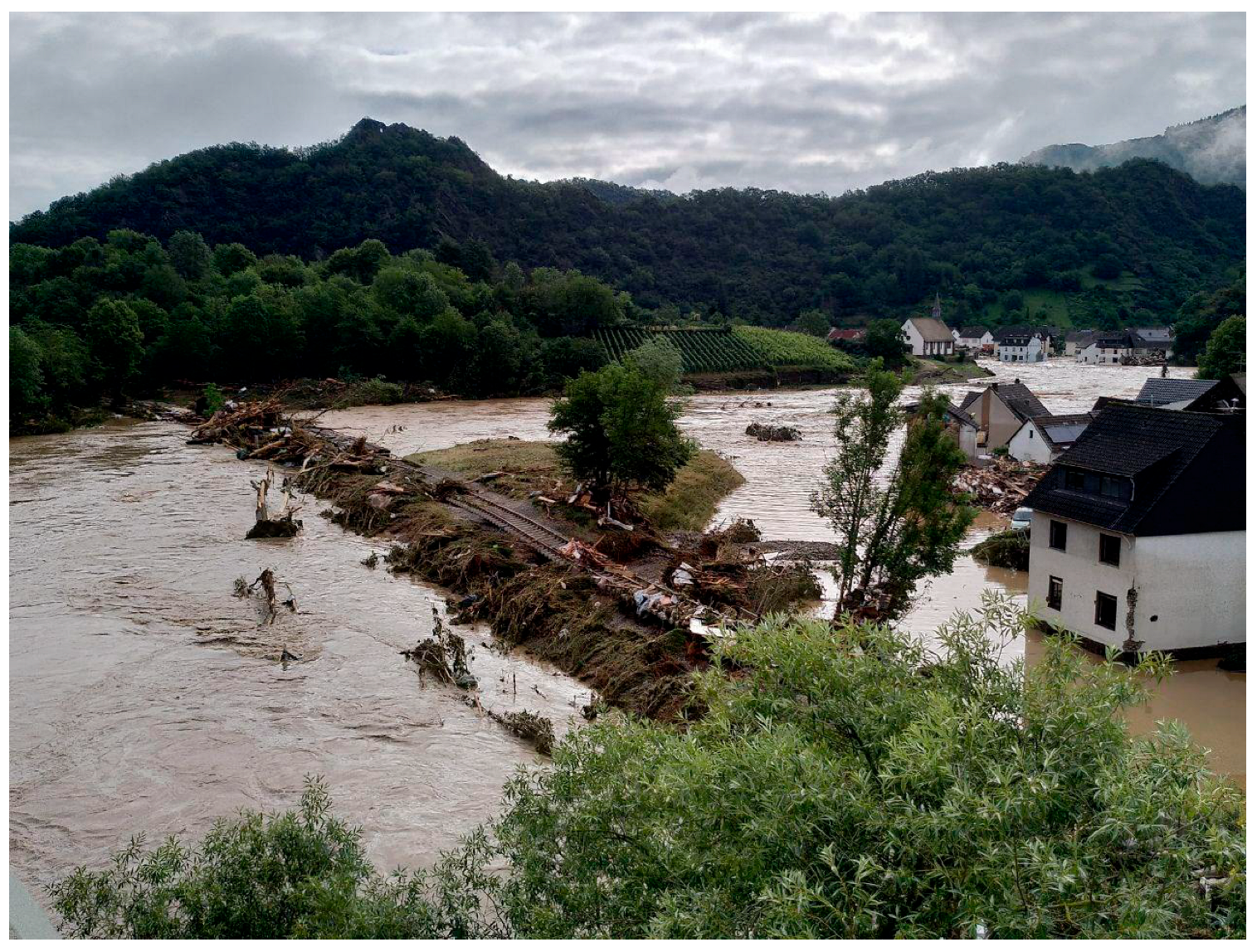
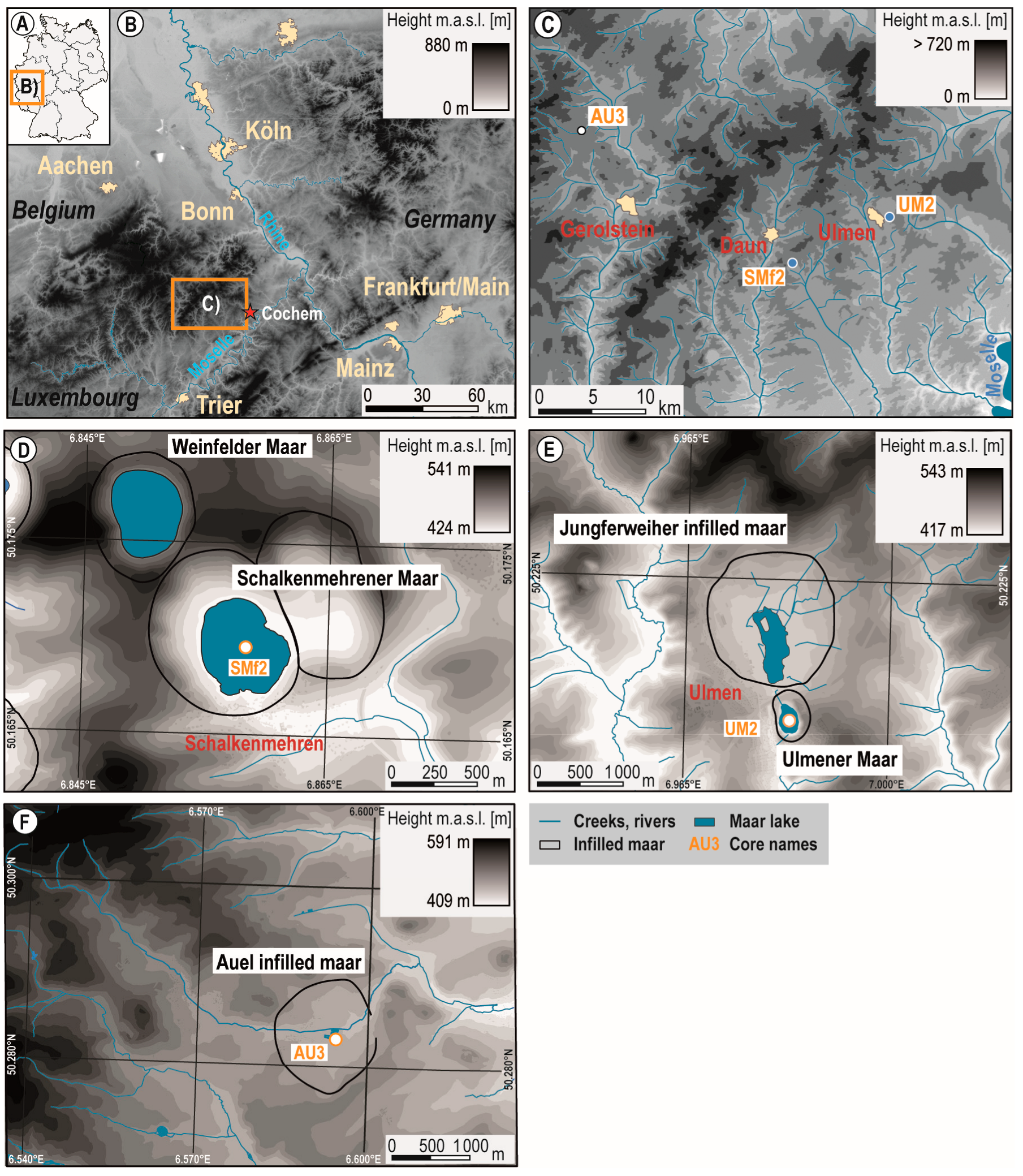

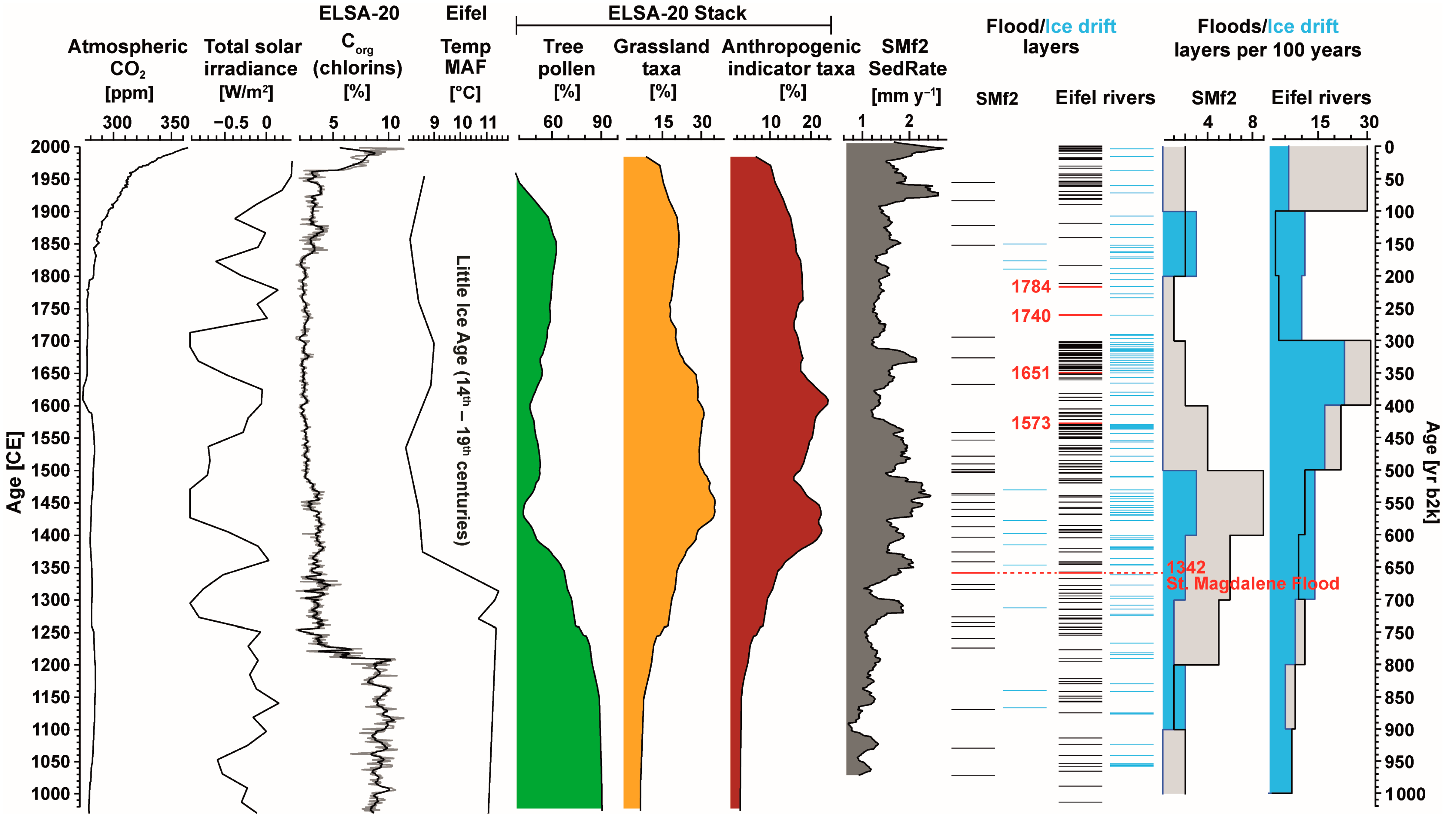
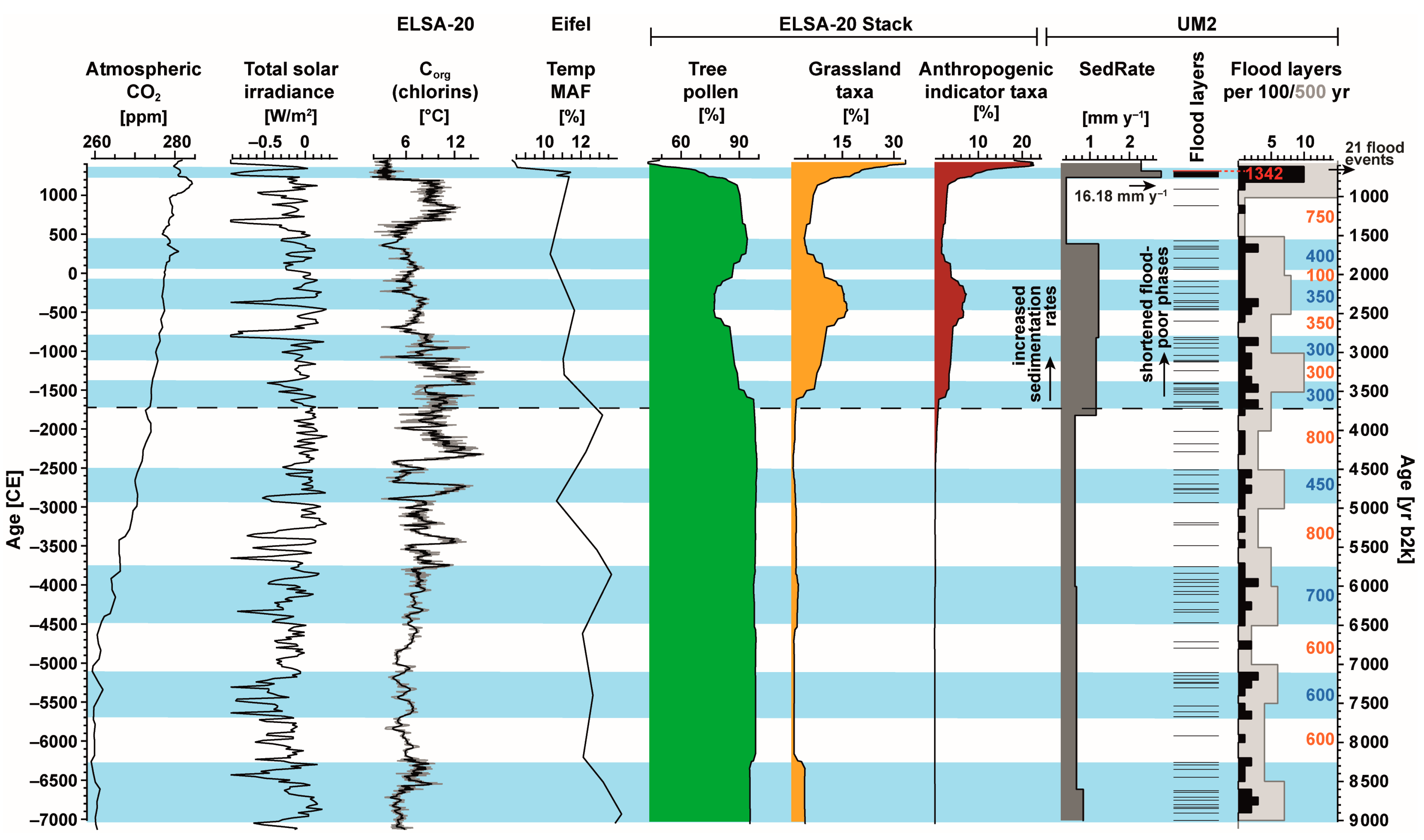
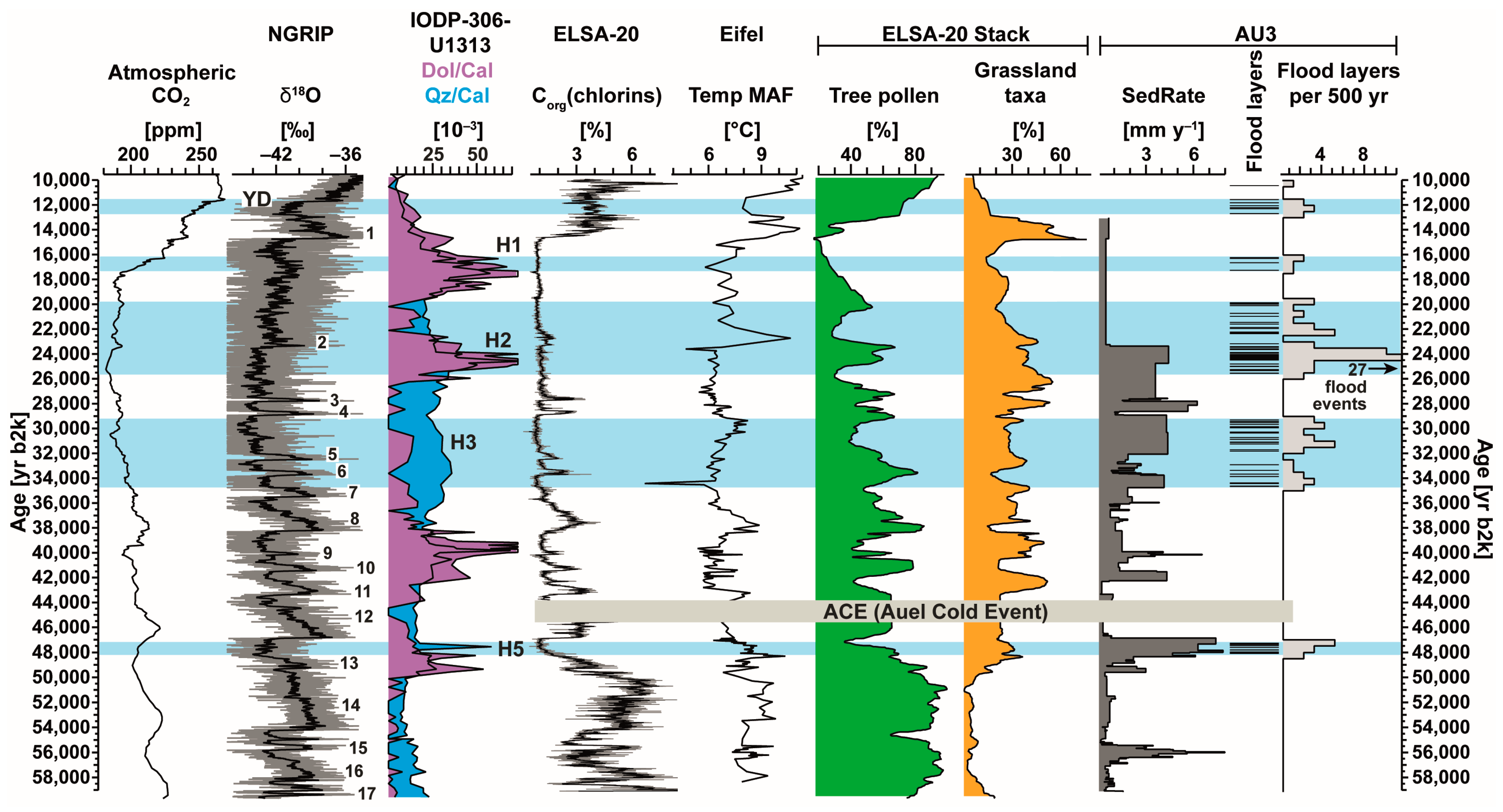
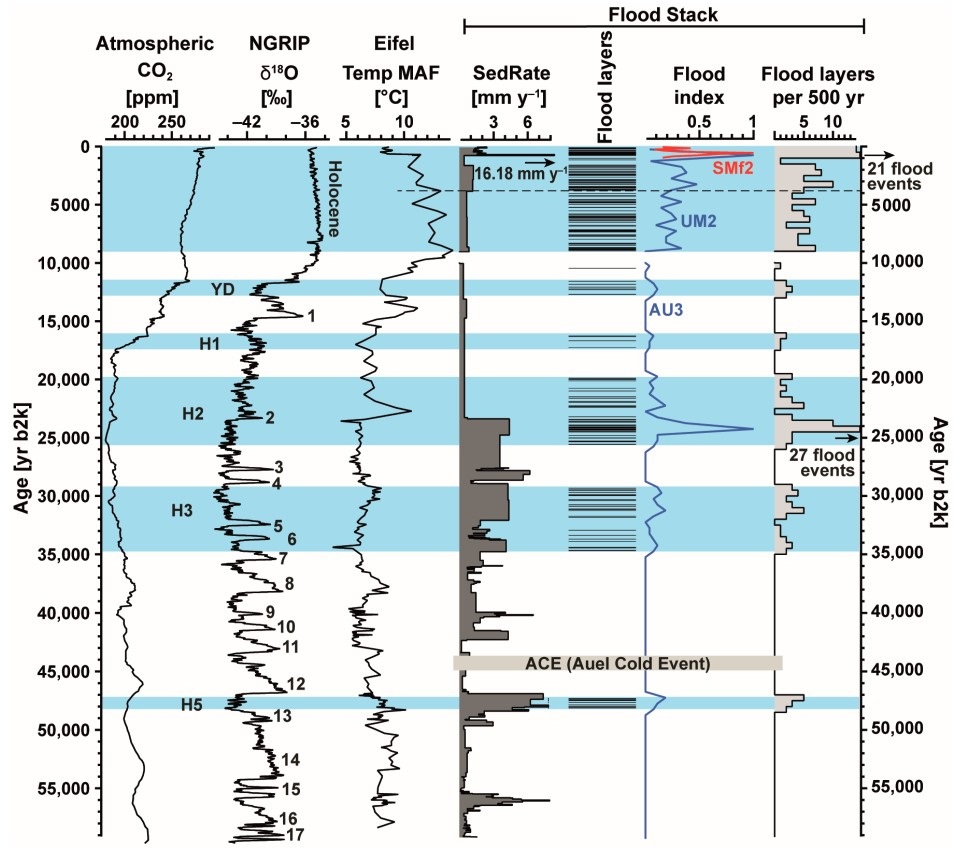
Disclaimer/Publisher’s Note: The statements, opinions and data contained in all publications are solely those of the individual author(s) and contributor(s) and not of MDPI and/or the editor(s). MDPI and/or the editor(s) disclaim responsibility for any injury to people or property resulting from any ideas, methods, instructions or products referred to in the content. |
© 2025 by the authors. Licensee MDPI, Basel, Switzerland. This article is an open access article distributed under the terms and conditions of the Creative Commons Attribution (CC BY) license (https://creativecommons.org/licenses/by/4.0/).
Share and Cite
Albert, J.; Sirocko, F. Holocene and Late Pleistocene Flood Events in Central Europe Reconstructed from Eifel Maar Lake Sediments. Quaternary 2025, 8, 69. https://doi.org/10.3390/quat8040069
Albert J, Sirocko F. Holocene and Late Pleistocene Flood Events in Central Europe Reconstructed from Eifel Maar Lake Sediments. Quaternary. 2025; 8(4):69. https://doi.org/10.3390/quat8040069
Chicago/Turabian StyleAlbert, Johannes, and Frank Sirocko. 2025. "Holocene and Late Pleistocene Flood Events in Central Europe Reconstructed from Eifel Maar Lake Sediments" Quaternary 8, no. 4: 69. https://doi.org/10.3390/quat8040069
APA StyleAlbert, J., & Sirocko, F. (2025). Holocene and Late Pleistocene Flood Events in Central Europe Reconstructed from Eifel Maar Lake Sediments. Quaternary, 8(4), 69. https://doi.org/10.3390/quat8040069





